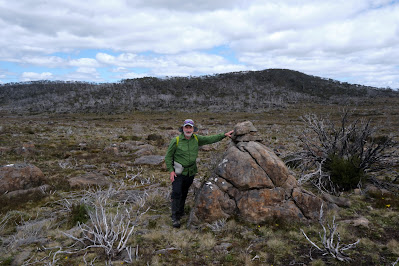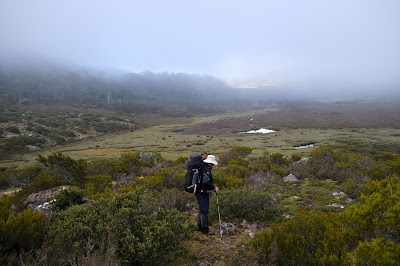The hut we’re hunting was built relatively recently, during our own bushwalking days, in 1985. It’s sometimes known as ‘Basil Steers No. 3’, but is universally nick-named ‘Smurf Hut’. Its construction was partly a protest against the government’s 1984 ban on snaring as a method of taking animals. Given that provenance, Basil built the hut in a hard-to-find location, towards one edge of the Februaries. (Honouring that intention, I will not reveal its exact location here.)
 |
[Tim points the way, with Overland Track mountains ahead] |
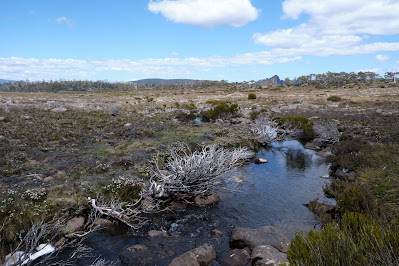 |
[February Creek, with Mt Pillinger on the horizon] |
Bit by bit we close in on those distant hills. Naggingly persistent feet manage this feat surprisingly well, although often at a cost. For an hour or more we’re high-stepping over knee high grasses and sedges. It’s not difficult walking, but it’s wearing. I’m encouraged when I finally see on Tim’s device that we’re closing in on the red dot marking the hut’s location. All the way I’ve been reassured by the fact that Tim has been to Smurf Hut before – hence the red dot.
What I don’t realise until we enter some gnarly scrub is that Tim has never come to the hut from the northern Februaries. Rather he’s previously approached it from the Arm River/Wurragarra Creek direction. When you’re in bauera, tea tree and scoparia scrub, being told you’re “maybe 200m from the hut” isn’t as comforting as it may sound. After some sweat-inducing wading through said scrub, Tim concedes that we are too far west. We need to back-track. However we’re unable to stomach a complete retreat, so we choose a “tactical withdrawal", going diagonally uphill.
We finally come out of the scrub into a pencil pine forest. This is promising, as Basil Steers and many other trappers/snarers preferred to use pines like these for building huts. Eventually we descend into the dim green of a myrtle rainforest, an even better sign, as Tim’s memory is that Smurf Hut is hidden deep in such a forest. And so it proves, as we eventually clamber down a small cliff, scramble over a series of mossy logs, and find the humble timber hut.
 |
[Smurf Hut, with Tim outside] |
Its name has always piqued my curiosity, but as we stoop to enter the hut, it explains itself. Everything about the hut is diminutive: the doorway; the size of the logs stored in the entryway; the height of the ceiling; the three wee bunks. It would be perfect for smurfs*. Indeed Tim and I agree it would be ideal for our friend Jim. Not only does he love a hut, especially one with a fire, but he is also – how shall we put this – a vertically-challenged man. The four foot long bunks would be perfect for him.
 |
[Tim inside the diminutive hut] |
We lunch outside the hut, soothed after our exertions by the cool quiet of the forest. After lunch I wander around the hut’s exterior. According to the late historian, Simon Cubit, the hut was never used as a skin shed, and certainly the walls show none of the signs of skins having been nailed there for drying or tanning.
We’ve learned lessons from our outward journey, and set off for our home lake via a less scrubby route. Although it’s still a long haul, all of it off-track, I’m pleasantly surprised to get back by mid-afternoon. While Tim soaks his hot feet in the lake I just sit back and enjoy being becalmed. Had we actually been sailing, it would have been a quiet afternoon.
 |
[Tim cools his feet] |
There’s just the occasional puff of wind, and the lake is still enough to reveal one further secret. On the far side we can see the tell-tale ripples of a platypus at work. Occasionally it surfaces, bill, nose and eyes briefly visible before it dives again. I am in awe of these amazing creatures, not least because they’re one of only two egg laying mammals in the world (along with echidnas). I’m also astonished how they’ve managed to occupy this small lake that’s far distant from any other reliable body of water. I once watched a platypus toddle over land, and concluded it was unlikely to set any land speed records. Yet here they are, as they are in so many isolated lakes, tarns and creeks in Tasmania.
 |
[A platypus walking overland] |
After dinner I dig out some of my writing and read it aloud to Tim. On this walk, and earlier by phone, we’d been discussing some of my lock-down work about ‘the spirit of bushwalking’. It’s good to read it, albeit to an audience of one. It’s even better to discuss some of the knotty issues with someone who shares my perspective on walking and spirituality. Tim offers some helpful suggestions, and we toss around ideas, agreeing that there will be on-going discussions. I feel encouraged to keep working on it. Being detached from the everyday seems yet again to clear the mind.
Gradually the blue day morphs into a dark jewel of an evening, and our honest day’s walk helps sleep to come swiftly. When the light of our final day leaks into our campsite, it reveals a mirror-flat lake, enticing us out for an early start. We have one more item on our agenda: to pick up the trail of cairns from day 2, and see if we can follow the old February Plains Stock Route out.
 |
[It's perfectly calm on our departure day] |
After all our years walking together, I should be aware that Tim’s journeys of discovery are rarely short-cuts. But as I’ve also been bitten by the exploration bug, the two of us happily fan out and scan for cairns. We walk far further west than we would otherwise need to, but are rewarded by the discovery of a series of cairns heading north. We follow these to Sardine Creek, near which we find some remnants of droving days. We feel sure that we have indeed been on the old February Plains Stock Route.
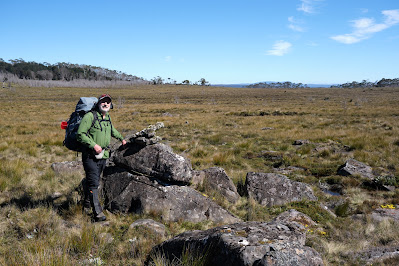 |
[Another cairn on the February Plains Stock Route] |
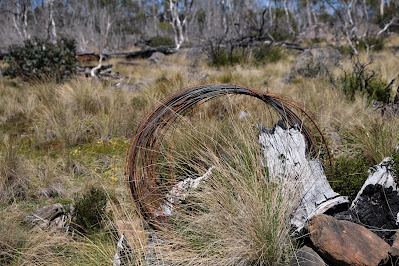 |
[Old fencing wire, possibly from the cattle droving days] |
 |
[A Smurf-blue sky bids us farewell] |
* For those who don’t know, smurfs are fictional creatures from the mind of Belgian comic writer “Peyo”. Small, blue and human-like, they live in mushroom-shaped houses in the forest.



